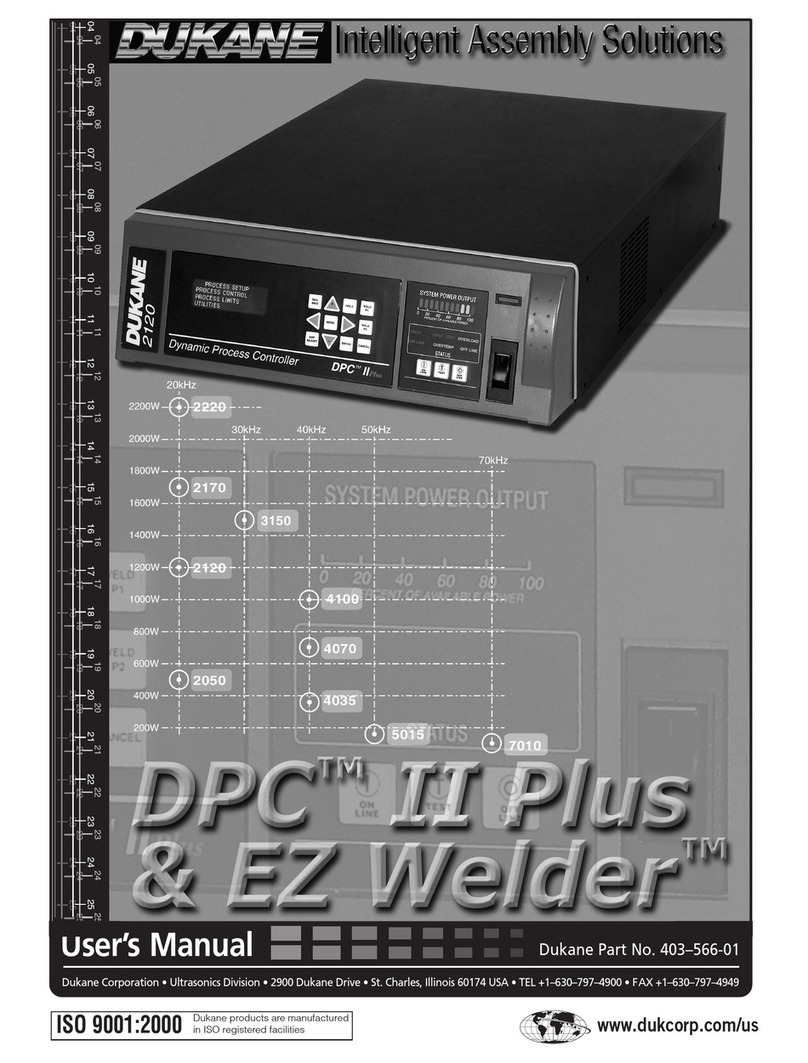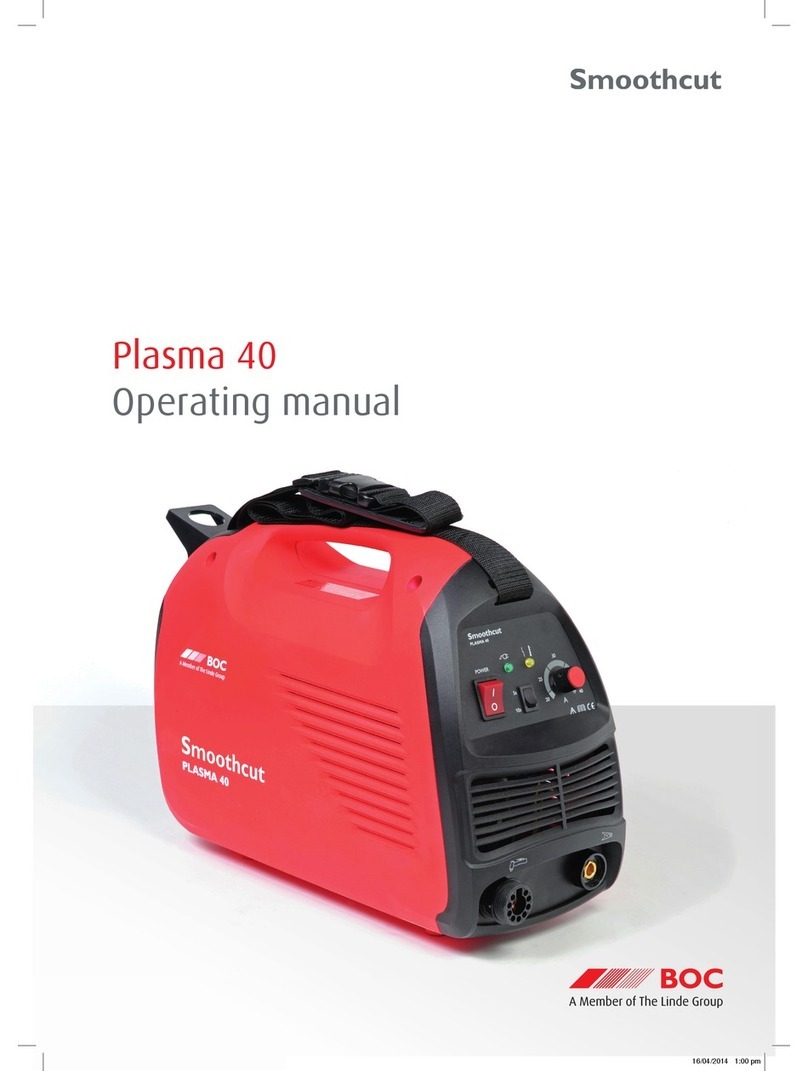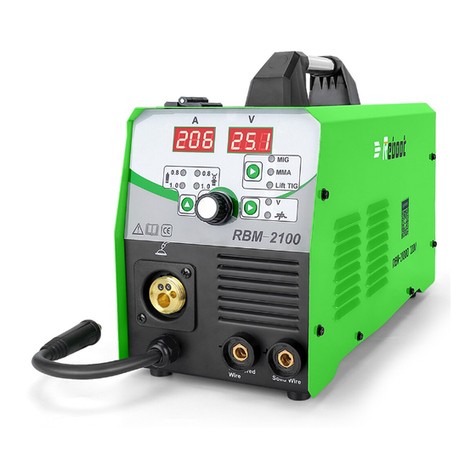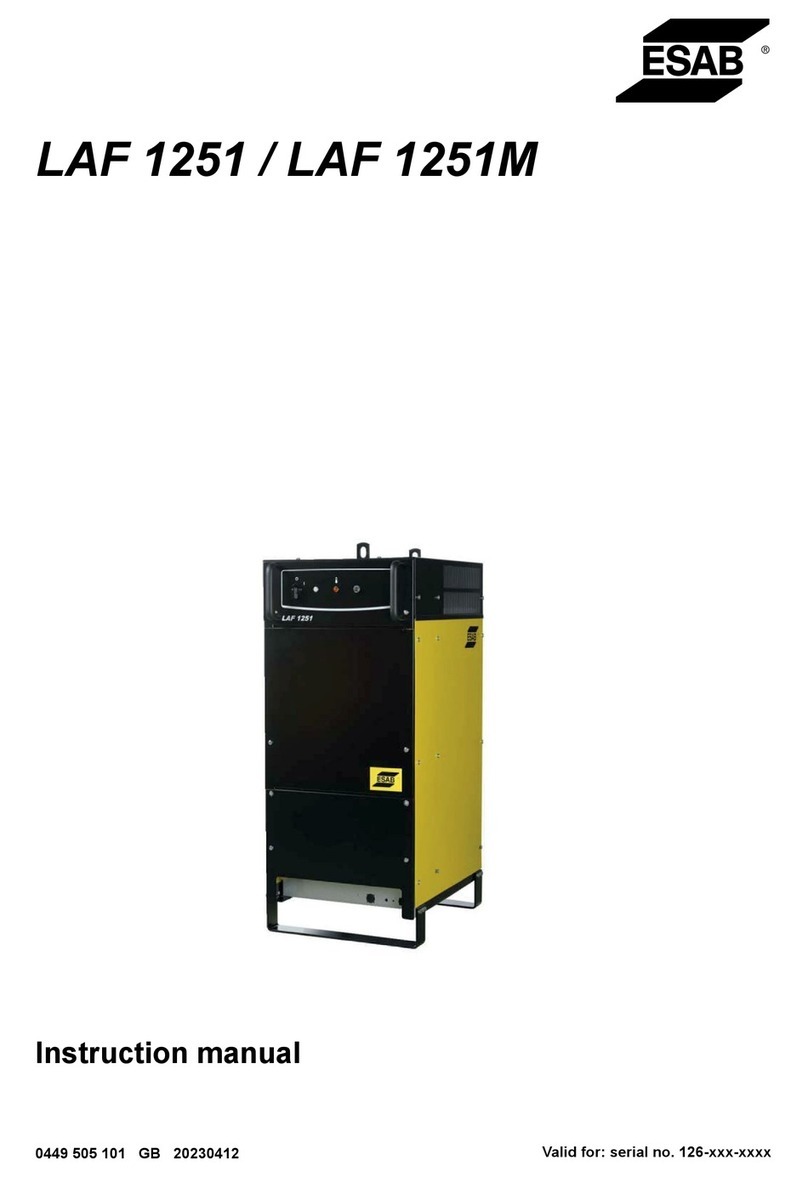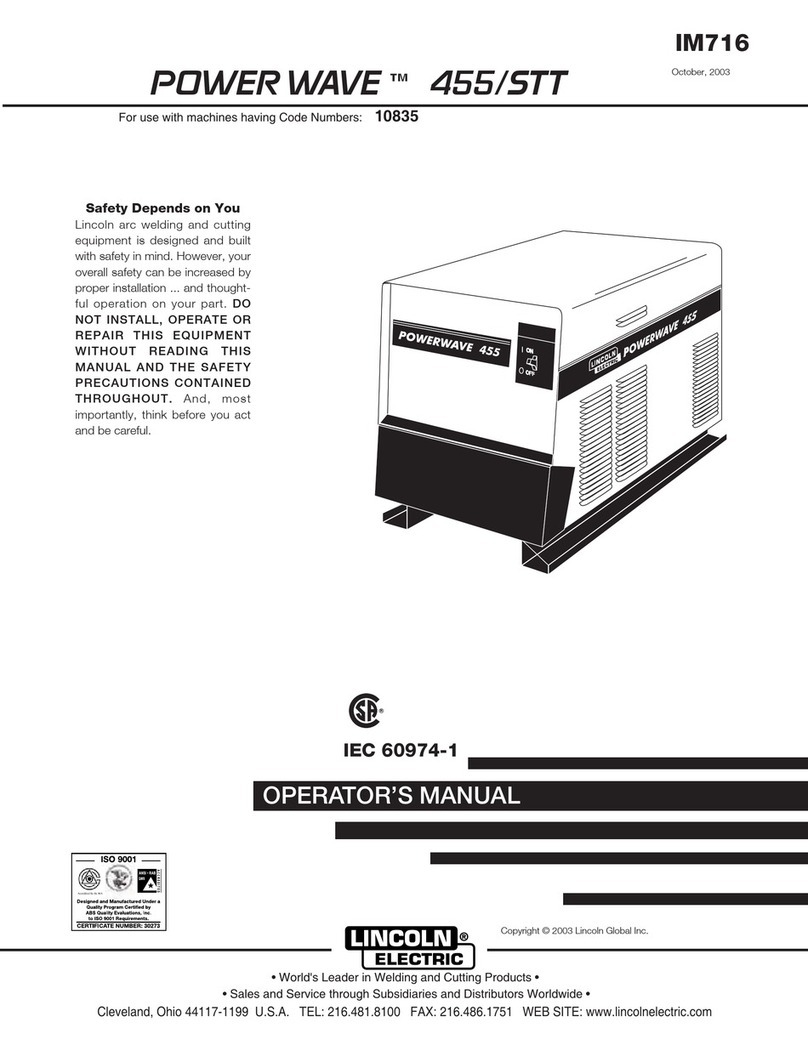GOODWIN P30 User manual

P32 Manual.p65 Issue 3 9th May 2008 Page : 1
OPERATION MANUAL
for the
GOODWIN P30
AIR PLASMA CUTTING SYSTEM
P30 Instruction Manual Revision : 5 9th May 2008

Page:2 P32 Manual.p65 Issue 3 9th May 2008
The Company reserves the right to make such changes to the design or specification of the
equipment as it shall see fit. The information contained in this manual is issued for the guidance
of users and does not form part of any contract. It is strongly recommended that all users and
supervisors familiarise themselves with the contents...
PRIOR TO COMMENCING USE OF THE SYSTEM
...and in particular, the section on safety precautions which should be used as a guide to
safe operation in accordance with the requirements of the relevant Health and Safety at Work
legislation.
GOODWIN AIR PLASMA LIMITED
KERNAN DRIVE
LOUGHBOROUGH
LEICESTERSHIRE
LE11 5JF
ENGLAND
Tel No. ++(0) 01509 237369
Fax No. ++(0) 01509 234942
Email. [email protected]

P32 Manual.p65 Issue 3 9th May 2008 Page : 3
Contents
1. ................................................................................................................................................. SAFETY 4
1.1 ................................................................................................................................................. General 4
1.2 .....................................................................................................................................Safety Features 5
1.3 ...................................................................................................................................... Warning Signs 5
1.4 ...................................................................................................Packaging Handling and Transport 5
2. ............................................................................INTRODUCTION TO THE PLASMA PROCESS 6
3. ................................................................................................................................... INSTALLATION 7
3.1 ....................................................................................................................................... Power Supply 7
3.2 ............................................................................................................................ Earth Requirements 7
3.3 ........................................................................................................................... Phase Determination 8
4. ........................................................................................ PLASMA AND TORCH CONNECTIONS 9
4.1 ................................................. Connecting the Torch and Plasma Earth Lead to the Power Unit 9
4.2 ...................................................................................................................... Control of Hand Torch 10
5 ........................................................................................................................................ OPERATION 11
5.1 ...............................................................................................................................Machine Controls 11
5.1.1 ..........................................................................................................................warning indicators 13
5.2 ......................................................................................................................... Power Up Procedure 14
5.3 ............................................................................................................................. Cutting Procedure 15
5.3.1. ....................................................................................................... Starting and Finishing a Cut. 15
5.3.2. ................................................................................................................Cutting With Stand Off. 15
5.3.3. ................................................................................................................................Cutting Speed. 16
5.3.4. ..........................................................................Piercing Thicker Materials with a Hand Torch 17
5.3.5. .................................................................................................... Piercing with a Machine Torch 18
5.4 ................................................................................................................................. Troubleshooting 19
5.5. .............................................................................................................................. Consumable Life. 19
5.5.1. ...................................................................................................................................Intrinsic Life. 19
5.5.2. ...................................................................................................................................... Alignment. 19
5.5.3. .........................................................................................................................Transient Damage. 19
5.5.4. .................................................................................................................... Operational Damage. 20
5.5.5. ................................................................................................................Electrode “non-starting”.20
5.6 .....................................................................................................................Changing Consumables 21
6. ........................................................................................................................... TECHNICAL DATA 23
6.1 ..........................................................................................................................................Power Unit 23
6.1.1. .............................................................................................................................. Electrical Input 23
6.1.2. ........................................................................................................................... Electrical Output 23
6.2 ............................................................................................................................ Torch and Hose Set 23
6.2.1 ......................................................................................................................................Hand Torch 23
7. ............................................................................................................... SERVICE INFORMATION 24
7.1 .................................................................................................................................. The Power Unit 24
7.1.1. .............................................................................................................................Circuit Diagram 25
7.1.2. ............................................................................................................................. Machine Layout 26
7.1.2. ....................................................................................................................Diagnostic Indicators. 28
7.2 ........................................................................................................The Torch and Hose Set Repair 29
7.3 ....................................................................................................................................... Maintenance 30
8. .....................................................................................................................................Torch Blockage 31
8.1 ................................................................................................................................... Machine Torch 31
8.2 ......................................................................................................... Machine Torch exploded View 32
8.3 .........................................................................................................................................Hand Torch 33
8.4 ...............................................................................................................Hand Torch exploded View 34
9. ........................................................................................................................................Fault Finding 35
10. ................................................................................................................................................... Index 36
A36

Page:4 P32 Manual.p65 Issue 3 9th May 2008
1. SAFETY
1.1 General
Before any cutting operations are started, the user must ensure that the installation and
proposed working methods comply with all relevant safety regulations, environmental and elec-
tricity standards.
The plasma arc produced at the torch head is a jet of high energy and is potentially danger-
ous. Users unfamiliar with a plasma arc should seek basic training. Goodwin Air Plasma can
offer comprehensive training courses.
In addition, the following points are particularly important:
a) Themainsconnection mustbeproperlygroundedandthe supplylinesfittedwithfuses of
thespecifiedrating.Themainscablemustbeproperly secured and protected frompossible
damage.
b) Highvoltageexistsatthetorchwhenpowerisappliedandthepilotarcisstruck(upto
95V),andwhenthemainarcis cutting (95V). Undernocircumstancesshouldanyone
touchthenozzlewithpowerappliedto the torch. Alladjustmentsandreplacementofparts
shouldbedonewiththepowerunitsupplyisolated.Thetorchshould not be used in
excessivelywetconditionsorifthetorchorhosesetaredamaged in any way.
c) Themainssupply shouldbeisolatedfromtheunit ATTHESUPPLYbeforeremovingany
panelsfromtheunit. Onlyauthorisedservicepersonnelshouldremovepanels.
d) Keeptheworkareaclear of allinflammablematerials.Ensurethatany material ejected
fromthe cut is nota hazard to the operatoror to others.
e) Protectionisnecessary againstultravioletradiationemittedfromthe arc.Ahelmetor
shieldwithshadeglassisrecommended. Wear gloves andadequateprotectiveclothing
whereappropriate.Adequatescreeningshouldbearrangedtoprotect others in the vicinity
orpassingbyinasimilar manner tothatrequiredforarcweldingoperations.
f) Adequateventilationor fumeextractiontoremovethecutting fume anddustisrequiredat
alltimesaroundany plasmacuttingoperation.Whencuttingflatsheet,ashallowwater
bedcuttingtablewill greatlyreducethefumesanddust whichmainlyoccurbelowthe cut.
g) Theplasmapowerunitshouldbepositionedon stable levelgroundandifnecessary
securedagainstany unwantedmovement.
h) Theoperationofthisequipmentand the plasmacuttingprocesscanresultin noiselevels
thatcouldbeharmful.The employer shouldundertakeanoiseassessmentto monitor
compliancewithrelevantlegislation.
i) Material to be cut should be supported in such a way that any material cut from the work
piece will not be a hazard and fall onto the user, the equipment, or others in the vicinity.
j) Care should be taken when manoevering the hose set with the hand held torch so that it
does not snag on objects or other equipment which may result in damage to the hose set, or
topple the objects or equipment. Excessive mechanical tension may result in damage to the
hose set connections or to the hose set components themselves.

P32 Manual.p65 Issue 3 9th May 2008 Page : 5
1.2 Safety Features
The plasma unit includes the following features for the safety of the operator:
* The body of the plasma torch is earthed.
* The continuity of the torch earth and the voltage on the body is monitored.
* Cutting current flowing in the supply earth is monitored.
* The voltage on the torch nozzle is monitored.
* In the event of a faulty condition of the above, the machine will switch off power to the
torch.
* The access door for the torch connections is interlocked.
The emergency stop procedure is to hit the red emergency stop button located on the lower front
control panel.
A tool (10mm spanner) is required to remove the canopy for access to the internal components.
Under no circumstances should the canopy be removed whilst the mains supply is still con-
nected. Only suitably trained and authorised personnel should remove the canopy.
1.4 Packaging Handling and Transport
Should the plasma unit need to be shipped, we recommend re-use of the original packing crate.
Also:-
a) That the hose set be disconnected to prevent any damage to the hose set / plasma connections.
b) That the control panel is adequately protected against potential damage.
c) Any lifting should be done using the eyebolt located in the top of the canopy together with
certified lifting equipment (not supplied). Precautions should be taken to prevent rotation about
the eyebolt.
d) The plasma unit should be shipped and stored in the upright position to avoid any heavy
internal components breaking free from their mountings.
e) Storage should be undercover, preferably in a clean dry environment.
1.3 Warning Signs
The location of the warning signs fitted to the
plasma unit are:
a) At the front of the machine -
Warning Open Circuit Voltage 300 volts.
b) At each rear lower corner of the canopy -
Warning Disconnect the Mains Supply.....
These should be maintained in a legible condition.

Page:6 P32 Manual.p65 Issue 3 9th May 2008
2. INTRODUCTION TO THE PLASMA PROCESS
The plasma process is created by passing a stream of clean ionised air, provided by an oil free
compressor, through a NOZZLE in the torch. The air stream is ionised by a PILOT ARC,
initiated by a HIGH FREQUENCY unit (HF Unit) which passes from the ELECTRODE to the
nozzle when the torch is activated. When the PILOT ARC is brought close to the work piece,
MAIN ARC is TRANSFERRED to the work piece as a jet of high energy which rapidly melts
any metal with which it makes contact, providing fast cutting, low residual heat input, and low
material distortion.
The electrode and nozzle are cooled by air (and water in water cooled torches), and as the air is
passed through the nozzle it is caused to swirl around the arc by a SWIRL BUSH to aid stability
of the arc.
The HF unit operates automatically to establish an arc when power is applied to the torch and it
ceases to operate when the pilot or main arc is established.

P32 Manual.p65 Issue 3 9th May 2008 Page : 7
3. INSTALLATION
May be carried out by a competent electrician. No specialist tools are required.
3.1 Power Supply
The power unit is provided with a length of flexible cable which must be connected to a 3 phase
and earth electrical supply. The supply should be fitted with fuses or circuit breakers of
appropriate rating and a means of isolating the power unit from the supply should be provided. A
plug should be fitted if appropriate. The machine is phase/rotation sensitive.
The power unit has power factor correction capacitors fitted as standard. It must be noted that when
the unit derives its power from a generator, the power factor correction may disturb the generators'
automatic voltage control. If recommended by Goodwin Air Plasma, the power factor correction
circuit can be disconnected however this will increase the input current demand.
Refer to the rating plate on the machine and Technical Data section 6.1.1. for the correct voltage
and current requirements.
3.2 Earth Requirements
The installation should be arranged such that the only path to earth (or ground) from the work
piece is by way of the plasma earth lead connected to the front of the machine.
Where the material to be cut forms part of the structure which is earthed or grounded to the
mains electrical supply system, then the cutting current could flow through that route rather than
the plasma earth lead to the machine. Always ensure that there is a good connection between the
work piece and the machine via the plasma earth lead as a poor connection will cause excessive
current in the mains supply earth which will create a current trip fault condition (see section 7.4
fault finding).
In installations where it is not possible to avoid earth current trips, even though a good cutting
current earth path has been ensured, it will be necessary to check that the alternative mains earth
paths are substantial enough to carry higher currents than the current trip setting of 10 amps
without causing damage, as where the cutting earth is not connected to the work piece at all, this
would be the full cutting current. If the earth paths are not substantial they must be uprated or re-
routed to avoid the possibility of damage. Once the necessary checks and precautions have been
taken, the earth current trip circuit may be disabled by means of the switch on the Earth Current
Relay (ECR) located inside the power unit.
PLASMA
TORCH
PLASMA
MACHINE
WORK
PIECE
MAINS
SUPPLY
PLASMA EARTH LEAD
POSSIBLE ALTERNATIVE PATH
+
-PLASMA
POWER SUPPLY
FOR CUTTING CURRENT
EARTH
CURRENT
RELAY

Page:8 P32 Manual.p65 Issue 3 9th May 2008
3.3 Phase Determination
Connectthetorchtothemachine(seesection4).
Fillthewatersystemwithdistilledwater.
Note. Toavoiddamagingthewater pumpthemachineshouldnotbe run withoutwaterinthe
system,also,themachineshouldnotberunformorethana few seconds without a torch connected to
themachine.
Switchonthemachinebyrotatingthemain isolatorandpressingthe on/offbuttonensuringthe
emergencystopswitch isunlatched.
Correctphaseconnectionis determinedbycheckingthatthecoolingairflowingthroughthepowerunit
isfromthefrontpaneltotherearof machine. Also, the waterreturnflow,withatorchconnected,can
beseenasajetofwaterinsidethe water tank through thefilleropeningoncethefillercapisremoved.If
thefanrotationnotcorrect,changetwoofthethreephaseconnectionsatthepowersupplyandcheck
again.
If there is any doubt regarding installation, consult your distributor or Goodwin Air
Plasma.
FanRotationAnti-
Clockwise
WaterJetinside
WaterTank
CompressedAir
CoolingRadiator OptionalWater
Filter

P32 Manual.p65 Issue 3 9th May 2008 Page : 9
4. PLASMA AND TORCH CONNECTIONS
4.1 Connecting the Torch and Plasma Earth Lead to the
Power Unit
EUROPLUGTORCH
CONNECTOR
WATERRETURN
WATERSUPPLY
DIAGRAM TO SHOW HOSE SET CONNECTIONS
Note. Donotrunthepowerunitwithoutthetorch connected.
POINTEDTOOL
Theplasmaearthleadisconnectedviathepush in and twist clockwisesocket.
Thewaterfittingscannotbefittedincorrectlyalthoughthereturnline(long) willfitinthesupplyoutlet
(short)forbackflushingthetorch.Toremovethewaterhoses,pushthewaterconnectorcollarsto
release(bothtogethertoavoidlossofwater).
Whenfirstswitchingon, allowenoughtimeforthewatertocirculatethroughthesystem.Asolid flow
ofwatershouldbeseeninsidethe filler orifice whenthefillercapisremoved,topupthe header tank as
required.Useonlydistilledor de-ionised water.(Seesection7.1 regarding useof methanolinfreezing
conditions).
Torchconnectiontothepowerunitismadebya
"pushin"connectorplugtoasocket on the front
ofthepowerunitdesignedto prevent accidental
removalofthehoseset.Apointedtoolis supplied
inthetoolkitforthe purpose ofallowingthehose
setto be connected and disconnected.
Toconnectthehoseset,inserttheconnectorplug
intothesocketandpressthepointedtoolintothe
smallhole(seeillustration),whilstrotatingthe
knurledsecuringcollar.
Notethatasealingringislocatedinthebaseofthetorchconnectorsockettoformanairsealwiththe
centrepowerpin.Care should be taken to ensure that this seal isnotdisplacedandthatthe end of the
pinisnotdamagedwhenthe torch plugisremoved.

Page:10 P32 Manual.p65 Issue 3 9th May 2008
4.2 Control of Hand Torch
The hand torch is provided with a press on / release off control switch on the handle for operation
of the plasma arc.
Note. Cooling air will flow through the torch at all times when the machine is switched on.
If a hand torch is to be used in conjunction with a mechanical manipulator or tractor unit etc.,
when the operation of the handle mounted press on / release off control switch will not be
possible, plug the remote control (optional extra) switch unit into the remote control socket as for
the machine torch.

P32 Manual.p65 Issue 3 9th May 2008 Page : 11
WARNING
INDICATORS
ON / OFF
BUTTONS
MAIN ISOLATOR
EMERGENCYSTOP
OUTPUT ON LAMP
AIR PRESSURE
GAUGE
AIRREGULATOR
RESET BUTTON VOLTMETER
5 OPERATION
5.1 Machine Controls
The front panel of the machine provides a range of displays and control gear to ensure correct
operation
ON / OFF BUTTONS
Switches auxiliary circuits on and off. ie Compressor, water pump, cooling fan and control circuits
MAIN ISOLATOR
Isolates machine from mains supply. It may be padlocked in the off position.
EMERGENCY STOP
Switchesmachineoff.Theswitch latchesmechanicallyandmustberotated torelease.

Page:12 P32 Manual.p65 Issue 3 9th May 2008
HOSE CONNECTIONS
See section 4. Connectiong the torch to the power unit.
VOLTMETER
Indicates the arc voltage.
Typical values would be: Power applied to torch but no arc 300v
For Pilot Arc 250 to 280 volts
For Main Arc 120 to 180 volts
OUTPUT ON LAMP
Indicates that power is applied to the torch.
RESET BUTTON
Resets earth current, earth safety, low arc voltage and water warning circuits.
AIR PRESSURE GAUGE
Displays the back pressure in the system during the pilot arc and cutting modes
Typical values would be: For Pilot Arc 0.7 to 1.4 bar (10 to 20 psi)
For Main Arc 2.4 to 3.4 bar (35 to 50 psi)
AIR REGULATOR
Sets the air flow through the torch to give a stable pilot arc.

P32 Manual.p65 Issue 3 9th May 2008 Page : 13
POWER
READY
TEMPERATURE
WATER
EARTH CURRENT
EARTH SAFETY
PILOT TRIP
LOW ARC VOLTAGE
POWER INDICATOR -
Indicates that power is available to the system control circuit.
READY INDICATOR -
Indicates system interlocks are operational and the machine is ready to cut
TEMPERATURE INDICATOR -
Indicates that the rectifier or transformer temperature is too high.
WATER INDICATOR -
Indicates insufficient water flow in the torch.
EARTH CURRENT INDICATOR -
Indicates excessive currents in the supply earth (see section 3.2).
EARTH SAFETY INDICATOR -
Indicates a break in the earth connection to the torch or a voltage in excess of 10 volts to the torch
body.
PILOT TRIP INDICATOR -
Indicates the pilot arc has excessive current, due to consumable condition or insufficient air flow.
5.1.1 WARNING INDICATORS
See section 7.1.2 Displays and Controls for more details.

Page:14 P32 Manual.p65 Issue 3 9th May 2008
5.2 Power Up Procedure
Having completed the mains and cutting earth wiring, connected the torch and checked the fan
rotation, the machine is ready for use.
Switch the machine on and after allowing time for the water to circulate through the torch, press
the reset button on the front panel. The red indicators should go out and the ready light will
illuminate.
To ascertain the absence of air leaks, the air regulator should be wound fully clockwise and the
pressure gauge should indicate a back pressure in excess of 1.6 bar.
It is now necessary to adjust the air pressure to give the highest possible reading consistent with
good arc starting and a stable pilot arc, this should around 0.9 bar. Switch on the torch with the
nozzle well clear of any work piece, person or equipment, and re-adjust the air pressure until it is
at maximum or the pilot arc becomes unstable (very noisy, misfire, and the voltmeter showing
300 volts). At this point reduce the pressure to restore stability (arc less noisy, stable arc, and the
volt meter showing 250/280 volts).
Always maintain as high an air pressure as possible for pilot arc as this gives the best consum-
able life.
The output neon is “on” and the voltmeter reads between 250 vdc and 280 vdc at this stage.
The machine is now setup and is now ready to be used. Before starting a cut please see section 1
for safety information and then section 5.3 for cutting procedure.
NOTE.
As plasma power units do not have a voltage stablised power supply, a fluctuation in the input
voltage will directly affect the output current. This may not be noticeable if the input voltage
rises slightly above the norm as it will provide more power for cutting. If the rise is excessive,
consumable life may suffer. However, when the input voltage falls, the output power also falls,
affecting both the pilot arc and main arc. In these circumstances it will be necessary to adjust the
air pressure regulator to reduce the airflow to obtain a stable pilot arc, and readjust it when the
mains voltage returns to normal.

P32 Manual.p65 Issue 3 9th May 2008 Page : 15
IMPORTANT
If the arc should “flare”, be coloured green, or emit any unusual noise, it is recommended that the
unit be immediately switched off and the condition of the consumables checked. Cutting under
these conditions may result in damage extending beyond the consumables to other parts of the
torch.
Under normal cutting conditions the torch is designed
to operate with a STAND OFF of about 6 mm (except
P50 8 mm). This is the distance between the end of the
nozzle and the work piece.
Where the work piece is rusty, scaly, or with thick
sections of steel or aluminium etc., a build up of dross
on the top of the work piece may occur which will
cause damage to the nozzle. In these conditions, the
stand off distance should be increased slightly.
A guide ring is avalable to assist the operator in
maintaining the desired stand off height. This can also
be used against a straight edge to maintain a straight
cut.
5.3.2.Cutting With Stand Off.
5.3 Cutting
Procedure
Where possible it is better to start a cut at a plate edge or hole because the piercing process
reduces consumable life.
Cuts can be started by either initiating the pilot arc and moving the torch into the proximity of the
work piece, or by positioning the torch over the edge of the work piece and starting the pilot arc.
Materials with a capacity to absorb heat energy, especially thicker sections, require more care and
technique when starting a cut. In these cases the cut will appear slow to start and pierce through
the material. Once a cut is established then cutting speeds may be increased.
Cuttingcanbestoppedeitherbyreleasingthetorchswitch,switchingoffthepower, or by withdrawing
from the workpiece (best done rapidly).
5.3.1.Starting and Finishing a Cut.

Page:16 P32 Manual.p65 Issue 3 9th May 2008
5.3.3.Cutting Speed.
Best results are usually obtained by cutting at the optimum cutting speed.
OPTIMUM CUTTING SPEED
Correct cutting speed is judged by experience from
observing the angle at which the cut material leaves
the lower edge of the plate, either by observing the
ejected material or by studying the surface of a cut
after completing a test cut. The drag back of the arc is
aproximately 30 degrees.
CUTTING TOO SLOW
Arc appears to blow straight through the material.
Excessive dross may accumulate on the underside of
the material.
CUTTING TOO FAST
Arc fails to pierce the material. Blow back of dross
will damage the nozzle.
MAXIMUM CUTTING SPEED
Drag back of the arc is around 45°, but cut quality will
deteriorate.

P32 Manual.p65 Issue 3 9th May 2008 Page : 17
5.3.4.Piercing Thicker Materials with a Hand Torch
Piercing will cause cut material to be ejected upwards which can be dangerous, and has a risk of
damaging the torch nozzle. This problem is worsened as material thickness increases because it
takes longer to pierce. If it is necessary to pierce, then it is best done by angling the torch and
gradually bringing it upright as piercing is completed.
Initiate the pilot arc and lay the torch over at approximately
60º
Begin twisting the torch slowly towards a vertical position
taking care to avoid ejected material from hitting the
nozzle. At the same time, the torch should be moved a
small distance along the work piece.
As piercing completes, the nozzle can be brought to vertical
and cutting can continue.
Ifthe torch is pivoted aboutthe nozzle there is ariskof material
being blown back onto the nozzle which will cause damage to
the nozzle or even to the torch itself.
*
Imaginary pivot point. X
X
X
X
X

Page:18 P32 Manual.p65 Issue 3 9th May 2008
5.3.5.Piercing with a Machine Torch
When using a machine torch, it is not generally possible to angle the torch for piercing.
Start the pilot arc above the work piece, and with the torch travelling at about half of the normal
cutting speed, lower the torch until main arc transfer occurs.
Once piercing is complete, the torch may be brought to normal stand off and cutting speed.
Goodwin Air Plasma offer an Automatic Height Control Unit as an optional extra for machine
torches integrated with profiling machines or robot arms. Ask your distributor or Goodwin Air
Plasma for further details.
STAND
OFF
20MM
15MM
10MM
NORMAL
ê
è
Positionthe torch around 20mm from the work
piece, start the pilot arc and torch manipulator
moving at half speed.
Lower the torch until main arc transfers.
At this point, the descent speed of the torch is
important. If it is too fast, the ejected molten
metal will damage the torch.
Continue to lower the torch slowly after arc
transferuntilthenozzle is 10mm from the work
piece.
Wait until the arc has completed piercing
through, then lower the torch and maintain a
normal stand off for the duration of the cut.
Cutting can now continue at the full
recomended speed.
è
èè
ê
ê
è

P32 Manual.p65 Issue 3 9th May 2008 Page : 19
Bevel is more noticeable on thinner sections and is more pronounced on the left hand side of a
cut. It is due to the clockwise swirling of the air induced by the swirl bush in the electrode assem-
bly. Bevel edges can be desirable as an aid to weld preparation, however it can be virtually elimi-
nated by reducing the cutting speed but at the expense of accumulated dross. For minimum bevel
cut clockwise around a component and anticlockwise in a hole.
5.5.Consumable Life.
A good consumable life is the single most important factor in achieving optimum cutting
economics of any plasma cutting unit. This life is dependent on the intrinsic life of the
consumables, correct alignment and the incidence of transient and operational damage.
5.5.1.Intrinsic Life.
The intrinsic life of the consumables is determined by the rate at which they are eroded by the arc
process. This erosion rate is however low, and in practice, the life is limited by other factors. The
insert in the centre will be eroded slightly each time the arc is struck eventually creating a visible
crater. The crater can be more than 2mm deep before the electrode is considered to be expired.
5.5.2.Alignment.
The alignment and construction of the Goodwin Air Plasma Torch is such that problems of
grinding and adjusting electrodes do not occur. With reasonable care taken in fitting the
consumables, alignment problems should not arise.
5.5.3.Transient Damage.
On starting directly onto main arc, it is occasionally possible to erode some of the copper from
the electrode before the arc settles onto the insert material. This generates a crater in the
electrode and the insert burns back to become flush. Consumable life is thus reduced if there is a
high number of starts relative to the total cutting time.
Cutting speed too slow. Torch consumables worn or damaged.
Insufficient air flow.
Damaged torch consumables. Nozzle blocked by dross or too close
to work piece. Insufficient air flow.
Nozzle orifice damaged. Electrode eroded “off centre”. Consumables
wrongly fitted.
Speed too high. Stand off too high. Arc not straight - consumables
damaged or misaligned.
Excessive dross on lower
edge of cut.
Double arcing.
Main arc not square to
work piece.
Excessive bevel or
rounded cut surface.
5.4
Troubleshooting

Page:20 P32 Manual.p65 Issue 3 9th May 2008
5.5.4.Operational Damage.
This is the most likely cause of limited consumable life. Since the arc is quite capable of cutting
copper, anything which causes the arc to deviate from the centre of the nozzle will result in
damage to the orifice. In extreme cases the arc passes not through the orifice but from the
electrode to the nozzle and from the nozzle to the work piece - DOUBLE ARCING, causing the
rapid erosion of copper from both electrode and nozzle.
The most common cause of these problems is from ejected cut material entering the orifice
particularly when piercing or obstructing the nozzle with the work piece.
It is best to operate within the maximum speed capabilities of the machine and avoid unnecessary
piercing or stop-start cutting whenever possible.
5.5.5.Electrode “non-starting”.
Occasionally, it may happen that it is difficult to start the pilot arc. This happens when the
oxidized material from the electrode insert is deposited over the surface of the copper electrode
and inside the nozzle. Starting can be improved by cleaning or scratching the surface of the
electrode with a wire brush or sharp implement. Always switch off the power unit before
removing the nozzle for this purpose. Once a “non-starting” electrode has been used a few times,
starting usually improves.
It is not good practice to fire the pilot arc continually in midair without striking the cutting arc as
this oxidizes the surface of the electrode and leads to “non-starting” problems.
Since cutting usually improves a non-starting electrode, it may be desirable to use a piece of
scrap material and start the main arc immediatly by positioning the torch close to the material
before switching on. Once started, continue to cut for as long as possible before trying to re-
initiate the pilot arc.
ILLUSTRATION TO SHOW ELECTRODE DAMAGE
NEW ELECTRODE USED ELECTRODE WORN OUT EXPIRED
Table of contents
Other GOODWIN Welding System manuals
Popular Welding System manuals by other brands
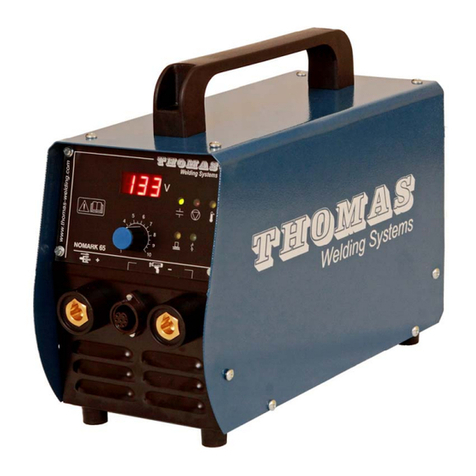
Thomas
Thomas NOMARK 65/99 operating manual
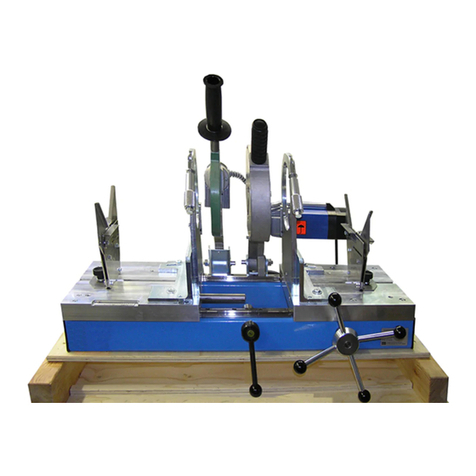
widos
widos 2500 / OD 160 Working Instructions Translation
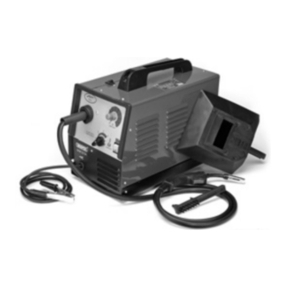
Draper
Draper MW130TA instructions

Lincoln Electric
Lincoln Electric INVERTEC 165S Operator's manual

Weldclass
Weldclass CutForce 43P operating instructions
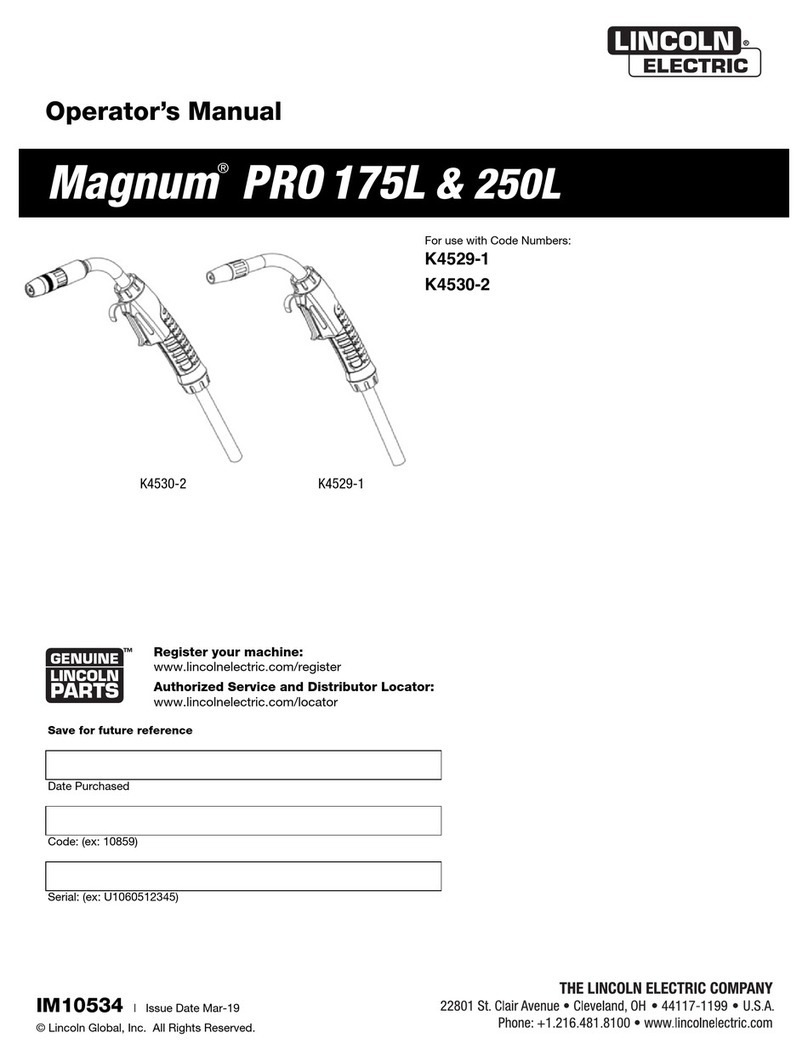
Lincoln Electric
Lincoln Electric Magnum PRO 175L Operator's manual


